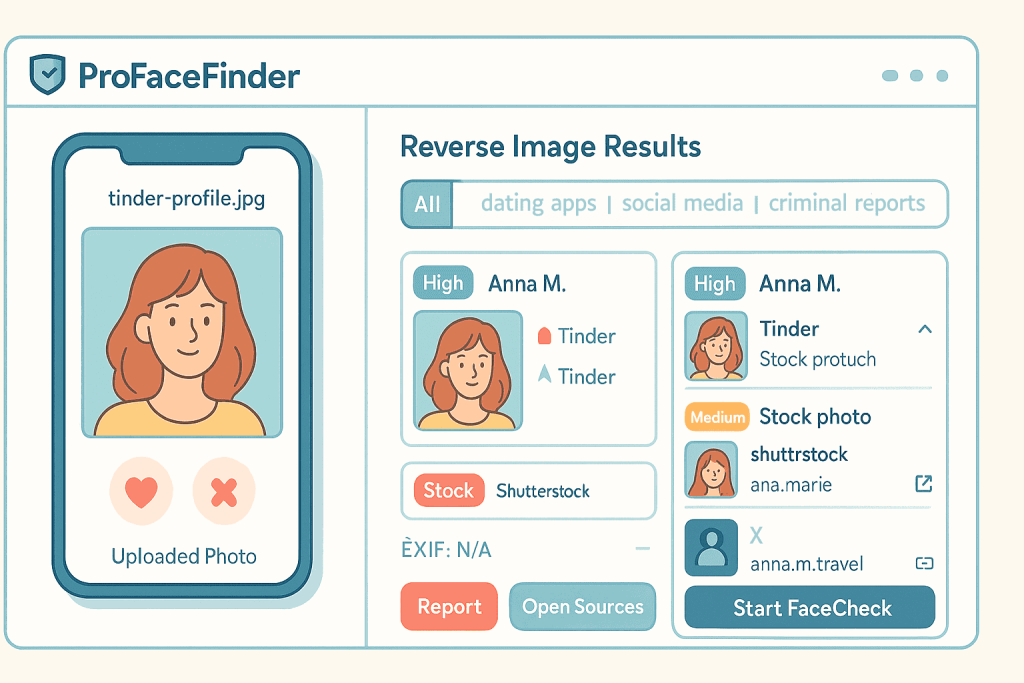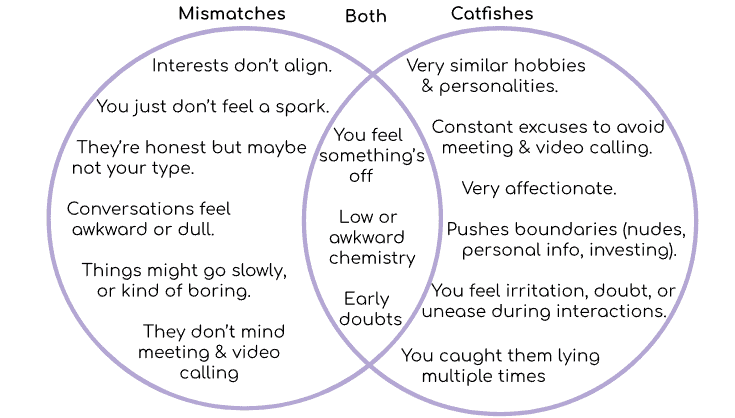Tinder can connect you to great people…and catfishes. They look perfect, are smooth talkers, and hit you with sketchy requests that are hard to say no to: money requests, investments, or pressure for private pics.
But just like everything, they leave clues as well. Let’s see what you should look into to detect a catfish before it gets too late.
Tinder Catfish Checker Reverse Image Search
Run their photo through ProFaceFinder — the fast, reliable catfish checker trusted by thousands.
It scans dating apps, social media, and even scam sites to reveal stolen images or shady profiles.
Peace of mind in minutes, Better Safe then Sorry.
If you need a fast and reliable way to see if someone on Tinder is real, try ProFaceFinder Catfish Image Search. It’s a state-of-the-art reverse image search tool that digs out dirt on people, your Tinder match included.
Step 1: Upload their profile photo (or any recent selfie they sent);
Step 2: Run the match and reverse search.
PFF finds look-alikes, recycled images, possible criminal offenders, and more.
It doesn’t only work for Tinder: it scans through multiple dating sites and social media platforms like Snapchat, Twitter, and more.

Having a safer experience on Tinder is possible. Check the signs below and determine whether the score is high enough to indicate you’re dealing with a Catfish online.
1. They Post & Send Only “Perfect” Photos
If every picture looks like it belongs to a model (perfect lighting, perfect angles, not a single casual shot), you might be talking to a profile that’s too good to be real.
Ask for a fresh selfie doing something specific, like holding up two fingers by a window. A real person won’t sweat it; a catfish will get defensive: “What, you don’t believe me?”, stall, or provide endless excuses.
2. Reverse-Image Search Results are Inconsistent
After you look up their images, compare names, locations, and bios. Catfish results are very inconsistent because the images are typically stolen. This is what to expect:
- The same image is being used by different people;
- Famous or semi-famous individuals;
- The picture is on model or Stock sites;
- The identity of the person in the image doesn’t fit your match, etc.
3. They Push You off Tinder Immediately
If they’re rushing you onto WhatsApp, Snapchat, or Telegram right away, it’s usually to dodge Tinder’s reporting system.
Tell them you’d rather stay on Tinder until you meet. A genuine match won’t mind. A scammer, however, may push or even ghost you because it’s easier than risking their account to get banned.
4. Their Schedule Makes Meeting Impossible
Do they always give excuses for why they can’t meet? Are they always unavailable? Offshore jobs, constant business trips, or never-ending shifts. Convenient, but if they wanted to meet, they would.
Suggest meeting for a quick coffee or joining them in a hobby they mentioned enjoying. If they keep dodging, it usually means one of two things: they’re either not genuinely interested or they’re lying about who they really are.
5. Intense Love-Bombing Immediately
Day 3 of talking and they’re planning your future, but you can’t even get them to video call? And the “baby, sweetie, bae, honey” parade has already started? Yeah, they’re bad news. Watch out for:
- Excessive petnames;
- The rushed “I love you”;
- Mentions of marriage;
- Attempts to make your relationship “official”.
Try to slow it down. Catfishes lose interest when you don’t match their pace.
6. Money Talk
If they start directing the conversation toward money, crypto, forex, “pay to get the gift I sent you”, or straight-up asking for gift cards, help with bills, stop. Block and Report immediately. Even if they try to guilt you with “I’m struggling.”
And if you don’t pay up they might switch to threats: exposing explicit pictures or personal info you shared. Another reason to shut it down, the second money or pressure appears.
7. Personal Details are Inconsistent

In case their story keeps shifting (new jobs, different schools, mysterious cities), look them up online. If the info they gave you doesn’t match up, they’re likely a catfish.
- Check their job’s/uni’s official social media accounts;
- Look their name up on Google or socials;
- Try to find their supposed relatives.
People’s online presence speaks volumes, and if they have none (or a very suspicious one), that means they’ve forged their identity.
How to Tell Bots Apart From Humans on Tinder

The scariest part is that bots and catfishes may be verified on Tinder. Know that a verified badge doesn’t guarantee their identity. Use it as a clue, but still ask for a live video, video calls, and a meeting.
Bots aren’t just stealing jobs: they’re stealing dates too. Bots and scammers usually want the same thing, so they mostly act the same.
They’ll reuse the same lines, dodge direct questions, reply with the wrong thing, and hit you with instant answers, even at 3 AM.
Try this:
- Ask for a voice note
- 1 live selfie, or
- A 1-minute video
The difference with robots is that they’re usually nonsensical. They have no personality to back up their answers, so they often talk gibberish.
For instance, if you were to ask them a quirky question like “What’s your favorite type of sausage?”, they’d either give a generic answer or something irrelevant.
Human catfishes/scammers are a bit trickier because their humanity allows them to manipulate people. Just watch out for the 7 signs above, and you should be fine.
Sometimes it’s hard to tell. A mismatch is normal because you simply don’t connect. A scammer has a plan to deceive. Here’s how to differentiate the two:
You Got Catfished. Now What?
Getting scammed cuts deep. The shock, embarrassment, even isolation…it feels like a breakup with extra betrayal.
Your first step should be prioritizing your safety, especially if you told them private information (address, credit card, etc.). Contact authorities just to make sure the catfish doesn’t come after you.
Next, to heal, break the loop of overthinking, lean on trusted friends, and don’t hesitate to talk to a professional if it weighs heavily.
What helps most? Humor. Inside jokes with friends or scrolling TikTok’s endless “catfish fails” (yes, people really use profile pics with the Google search bar still showing).
Here’s a practical reset:
- Swipe break (a week minimum).
- Re-set boundaries (decide what you’ll share, and when).
- When back: video calls first, Share My Date for safety, and never rush off the app.
Dating apps aren’t transparent about how often verification fails or how many scams slip through. Until that changes, go by these simple rules: Ask to see them live. Don’t rush. Never send money.


Leave a Reply